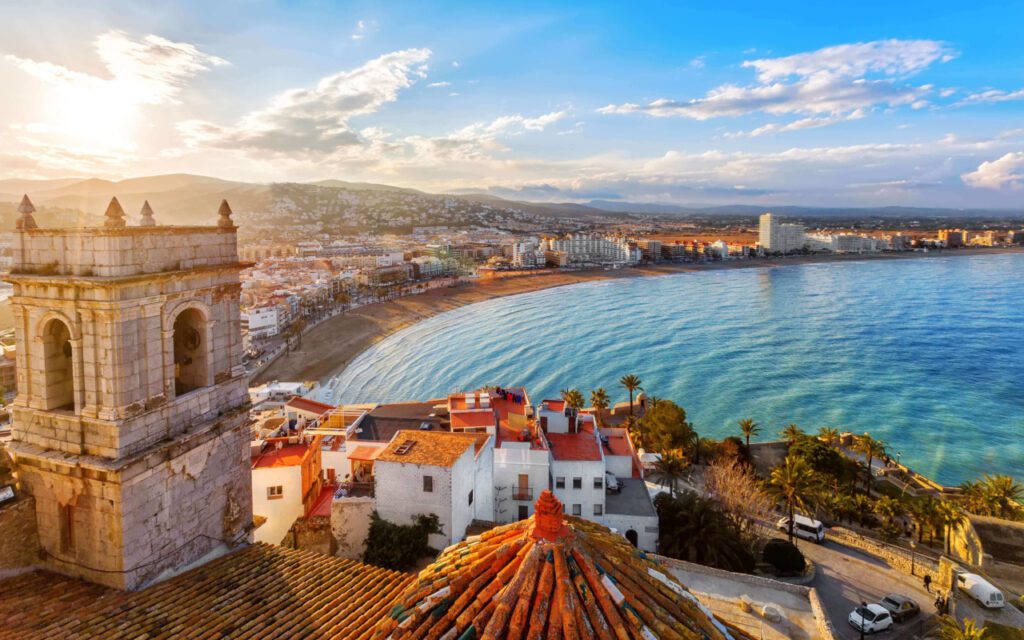Spain, with its sun-drenched beaches, vibrant cities, and rich cultural heritage, welcomes visitors year-round. But when exactly should you plan your Spanish adventure? The best time to visit Spain is during the shoulder seasons of spring (April to May) and fall (September to October) when you’ll enjoy pleasant temperatures, fewer crowds, and reasonable prices. However, the ideal timing depends entirely on what you’re looking to experience in this diverse country.
This comprehensive guide breaks down Spain’s seasons, regional variations, and special events to help you plan the perfect Spanish getaway based on your specific interests, budget, and travel style.

Understanding Spain’s Seasons (Detailed Breakdown)
Spain in Spring (March, April, May): The Sweet Spot
Weather
Spring brings mild temperatures throughout Spain, with southern regions warming faster than the north. In Andalusia, temperatures typically range from 65-80°F (18-27°C) by May, while northern Spain remains cooler at 55-70°F (13-21°C). The countryside bursts with wildflowers, creating picturesque landscapes perfect for photography.
Crowds
Tourist numbers are moderate, with a noticeable increase as May approaches. Major attractions are accessible without the suffocating summer crowds, and you’ll find it easier to interact with locals.
Costs
Accommodation and flight prices remain reasonable until late May when they begin to climb toward peak season rates. This makes spring an excellent value period for travelers.
Key Events/Festivals
- Semana Santa (Holy Week) – Elaborate processions and ceremonies throughout Spain, especially impressive in Seville and Málaga
- Feria de Abril (Seville) – Colorful fair with flamenco, food, and festivity following Holy Week
- Madrid San Isidro Festival (May) – The capital’s biggest festival with music, bullfights, and traditional events
Best For
Cultural exploration, city breaks, hiking in natural parks, countryside tours, and photography enthusiasts. Spring offers the perfect balance of pleasant weather and manageable crowds for sightseeing.
Potential Downsides
Spring showers can occur, particularly in March and in northern regions. Semana Santa attracts significant crowds and higher prices in popular destinations like Seville.
Spain in Summer (June, July, August): Sun, Sand & Crowds
Weather
Summer brings intense heat, especially in central and southern Spain where temperatures regularly exceed 95°F (35°C). Madrid and Seville can become particularly scorching. Coastal areas benefit from sea breezes, while northern Spain enjoys milder temperatures around 75-85°F (24-29°C).
Crowds
This is peak tourism season across Spain. Popular beaches, major cities, and islands become extremely crowded. Expect lines at attractions and packed restaurants in tourist hotspots.
Costs
Summer sees the highest prices for flights, accommodations, and many activities. Advanced booking is essential, especially for coastal destinations.
Key Events/Festivals
- San Fermín & Running of the Bulls (Pamplona, July) – World-famous festival and controversial bull runs
- La Tomatina (Buñol, late August) – The famous tomato-throwing festival
- Numerous music festivals including Primavera Sound, FIB, and Sonar
Best For
Beach vacations, island hopping, nightlife enthusiasts, and northern Spain exploration. Families often prefer summer due to school holidays despite the crowds.
Potential Downsides
Intense heat can make sightseeing uncomfortable in many regions. Overcrowded attractions diminish the experience, and high prices strain travel budgets. Many local businesses and restaurants close in August when Spaniards take their own vacations.
Spain in Autumn (September, October, November): Golden Hues & Harvests
Weather
Early autumn remains warm and pleasant throughout most of Spain. September offers summer-like conditions but with gradually moderating temperatures. By November, the weather becomes cooler and rainfall increases, especially in the north and central regions.
Crowds
Tourist numbers decline significantly after summer. September still attracts visitors, but by October and November, you’ll find much quieter conditions at major attractions.
Costs
Prices decrease progressively throughout autumn, with good deals available from mid-October onward. This makes fall an excellent value season for travelers.
Key Events/Festivals
- Wine harvest festivals in La Rioja, Jerez, and other wine regions
- San Sebastián International Film Festival (September)
- All Saints’ Day (November 1) – A significant cultural observance throughout Spain
Best For
City exploration, cultural experiences, food and wine tourism, hiking in comfortable temperatures, and photography of fall landscapes.
Potential Downsides
Weather becomes less predictable later in the season, with increased chances of rain, particularly in northern regions. Some smaller coastal towns begin reducing services after peak season.
Spain in Winter (December, January, February): Mild South, Cool North & Festive Cheer
Weather
Spain experiences varied winter conditions. Southern regions like Andalusia and the Canary Islands remain mild (55-65°F/13-18°C), while northern and central Spain can be cold, wet, and occasionally snowy. Madrid’s winters are chilly with temperatures averaging 40-55°F (4-13°C).
Crowds
Winter sees the lowest tourist numbers overall, except during the Christmas/New Year period and in ski resorts. This makes it ideal for experiencing a more authentic Spain.
Costs
Excluding holiday periods, winter offers the best travel deals with significantly reduced accommodation rates and flight prices.
Key Events/Festivals
- Christmas markets in major cities
- Nochevieja (New Year’s Eve) celebrations
- Three Kings Day (January 6) – Spain’s traditional gift-giving day
- Carnival (February) – Especially vibrant in Cadiz, Tenerife, and Sitges
Best For
Budget travel, city exploration without crowds, skiing in the Pyrenees or Sierra Nevada, winter sun in the Canary Islands, and experiencing authentic local culture.
Potential Downsides
Cold and potentially wet weather in many regions, shorter daylight hours, and some attractions operating on reduced winter schedules or closed for renovation.
Best Time to Visit Spain by Month
What’s Spain like in January?
January brings cool temperatures throughout most of mainland Spain: Madrid (32-50°F/0-10°C), Barcelona (41-57°F/5-14°C), while Seville stays milder (45-60°F/7-16°C). The Canary Islands remain pleasant around 64-70°F (18-21°C). This is low season with minimal crowds except in ski areas. Costs are at their lowest, and Three Kings Day (January 6) offers a unique cultural experience.
What’s Spain like in February?
February continues with winter conditions, though days gradually lengthen. Madrid and Barcelona remain cool, while southern regions show early signs of spring. Carnival celebrations bring color and festivities, especially in Cadiz and Tenerife. Almond blossoms begin in regions like Mallorca. Tourism remains low except during Carnival events, keeping prices affordable.
What’s Spain like in March?
March signals the arrival of spring with temperatures warming noticeably, especially in the south. Madrid averages 45-65°F (7-18°C), Barcelona 48-63°F (9-17°C), and Seville 50-70°F (10-21°C). Rain can occur, particularly in northern regions. Semana Santa preparations begin, and tourist numbers start increasing. Prices remain reasonable except during Holy Week if it falls in March.
What’s Spain like in April?
April epitomizes spring in Spain with comfortable temperatures and blooming landscapes. This month often hosts Semana Santa (Holy Week), Spain’s most significant religious festival, which brings crowds and higher prices to cities like Seville and Málaga. Weather is generally pleasant for sightseeing with temperatures reaching 55-75°F (13-24°C) in most regions.
What’s Spain like in May?
May offers near-perfect conditions across Spain with warm days and cool evenings. Southern Spain becomes quite warm, while northern regions enjoy mild temperatures. Madrid celebrates its San Isidro festival, and crowds begin building toward summer levels. Prices increase but remain below peak season rates. Beaches begin to attract visitors, especially in warmer southern regions.
What’s Spain like in June?
June marks the beginning of summer with warm to hot temperatures nationwide. School holidays haven’t fully started, creating a sweet spot with good weather but without July/August crowds. Barcelona averages 65-80°F (18-27°C), while Seville can reach 90°F (32°C). Beaches grow increasingly popular, and numerous festivals occur throughout the country.
What’s Spain like in July?
July brings peak summer conditions with high temperatures, maximum crowds, and premium prices. Inland cities like Madrid and Seville experience intense heat (often exceeding 95°F/35°C). Coastal areas fill with domestic and international tourists. Reservations become essential for accommodations and popular restaurants. San Fermín festival in Pamplona attracts global attention.
What’s Spain like in August?
August continues the summer peak with scorching temperatures throughout much of Spain. This is when many Spaniards take their own vacations, heading to coastal areas or leaving the country. Some small businesses close, especially in Madrid. The islands and beaches reach maximum capacity, and La Tomatina festival creates a unique attraction in Buñol.
What’s Spain like in September?
September offers one of the best travel windows for Spain. Summer heat moderates while sea temperatures remain warm for swimming. Tourist crowds thin noticeably after the first week, yet everything remains open. Wine harvests begin, creating wonderful opportunities for food and wine tourism. Prices start decreasing from summer peaks.
What’s Spain like in October?
October brings autumn colors and comfortable temperatures throughout Spain. This shoulder season sweet spot features mild weather (Madrid: 50-70°F/10-21°C), significantly reduced crowds, and lower prices. Northern Spain may experience increased rainfall. Fall festivals celebrate harvests, mushroom foraging, and cultural events in an authentic atmosphere.
What’s Spain like in November?
November transitions Spain toward winter with cooler temperatures and increased chance of rainfall. Southern regions and the Canary Islands remain mild and pleasant. Tourist numbers reach annual lows except around All Saints’ Day (November 1). This creates excellent opportunities for budget travel and experiencing local culture without crowds.
What’s Spain like in December?
December brings winter conditions to most of Spain, though severity varies by region. Christmas markets and holiday decorations create festive atmospheres in cities and towns. The first half of December offers excellent value and few crowds, while the Christmas/New Year period sees increased domestic tourism and higher prices. The Canary Islands remain a popular winter sun destination.
Best Time Based on Your Interests & Travel Style
Best Time for Beaches & Islands
The Mediterranean coast and islands shine from June through September when sea temperatures are warmest (70-75°F/21-24°C). For fewer crowds with still-pleasant conditions, aim for June or September. The Canary Islands offer year-round beach weather, with winter temperatures averaging 70°F (21°C).
Best Time for City Breaks
Spring (April-May) and fall (September-October) provide ideal conditions for exploring Madrid, Barcelona, Seville, and other Spanish cities. These periods offer pleasant temperatures for walking, minimal rain, and moderate tourist numbers. Avoid August in Madrid when heat peaks and many locals leave.
Best Time for Hiking & Outdoors
Late April through June and September through October offer the best conditions for hiking across most of Spain. Northern routes like the Camino de Santiago benefit from moderate temperatures, while southern regions avoid summer heat. The Picos de Europa are best explored from June to September when mountain passes are clear.
Best Time for Skiing
December through March provides reliable snow conditions in Spain’s ski destinations. The Pyrenees typically offer the longest season, while Sierra Nevada in southern Spain (Europe’s southernmost ski resort) sometimes extends into early May. January and February provide the most consistent snow quality.
Best Time for Food & Wine
Autumn reigns supreme for culinary travelers, especially September and October during harvest seasons. Wine regions like La Rioja, Ribera del Duero, and Jerez come alive with harvest festivals. Spring also offers excellent food tourism opportunities with fresh seasonal ingredients.
Best Time for Budget Travel
January through March (excluding holidays) delivers the best value. November (after All Saints’ Day) also offers excellent deals. During these periods, accommodation prices can be 30-50% lower than peak season, and flight deals abound.
Best Time to Avoid Crowds
Visit from mid-November through mid-December or January through February (excluding holiday periods) for the quietest experience. These periods allow for more authentic interactions and crowd-free attractions, though some coastal areas may feel too quiet with reduced services.
Best Time for Families
Easter break offers pleasant weather and family-friendly festivals. Early June provides excellent conditions before peak summer crowds arrive. October half-term presents another good window with comfortable temperatures and reduced crowds.
Regional Variations: A Closer Look
Best Time for Andalusia (South)
Spring (March-May) and fall (September-October) are ideal for exploring Seville, Granada, Córdoba, and the southern coast. Summer brings extreme heat (regularly exceeding 100°F/38°C) that makes sightseeing uncomfortable. Winter remains mild enough for pleasant visits, especially along the Costa del Sol.
Best Time for Catalonia & Barcelona (Northeast)
May, June, September, and October offer perfect conditions for Barcelona and the Costa Brava. Summer brings crowds and humidity, while winter provides a quieter, cool urban experience. Spring showcases Barcelona’s architecture in beautiful light with fewer tourists than summer.
Best Time for Madrid & Central Spain
Spring and fall provide relief from central Spain’s climate extremes. Madrid experiences hot summers (regularly 95°F/35°C) and cool winters that can bring occasional snow. May and October offer particularly comfortable conditions for exploring the capital and nearby historical cities like Toledo.
Best Time for Northern Spain (Basque Country, Galicia, etc.)
Summer (June-August) provides the most reliable weather for northern Spain, which experiences significant rainfall throughout the year. This region offers a perfect refuge from southern Spain’s summer heat. Spring and early fall can also be lovely but with increased chances of rain.
Best Time for the Balearic Islands (Mallorca, Ibiza, etc.)
Late May through June and September offer ideal conditions with warm temperatures, swimmable seas, and fewer crowds than July and August. Winter brings quiet, authentic experiences with mild temperatures (55-65°F/13-18°C) but many seasonal businesses close.
Best Time for the Canary Islands
The Canary Islands enjoy year-round spring-like conditions, making them a perfect winter sun destination. Average temperatures remain between 64-75°F (18-24°C) throughout the year. December through February brings northern European visitors seeking winter warmth, while summer sees Spanish mainlanders on holiday.
Key Spanish Festivals & Events Calendar
- January: Three Kings Day (nationwide, January 6)
- February/March: Carnival (nationwide, especially Cadiz and Tenerife)
- March/April: Semana Santa/Holy Week (nationwide, especially Seville and Málaga)
- April: Feria de Abril (Seville, two weeks after Easter)
- May: Madrid San Isidro Festival, Córdoba Patios Festival
- June: Pride celebrations (especially Madrid), San Juan bonfires (coastal areas, June 23)
- July: San Fermín & Running of the Bulls (Pamplona, July 7-14), numerous music festivals
- August: La Tomatina (Buñol, last Wednesday), numerous local festivals
- September: Wine harvest festivals, La Mercè (Barcelona)
- October: Fiestas del Pilar (Zaragoza), regional autumn festivals
- November: All Saints’ Day (nationwide, November 1)
- December: Christmas markets, New Year’s Eve celebrations
Note: Always check official tourism websites for exact dates, as some festival dates vary annually based on Easter and local calendars.
Practical Planning Tips Tied to Timing
Booking Flights & Accommodation
For summer travel (especially August), book at least 4-6 months ahead. Spring and fall require 2-3 months advance planning. Winter (except holidays) offers last-minute deals. Flight prices to Spain typically increase 30-50% during peak summer season compared to winter months.
Packing Essentials by Season
- Spring/Fall: Layers are essential. Pack light jackets, scarves, and mix of short and long sleeves
- Summer: Lightweight, breathable clothing, sun protection, and swimwear
- Winter: Warm layers for northern/central regions; lighter layers plus a jacket for south and islands
Understanding Costs
- Budget travel: €70-100/day (off-season, hostels/budget accommodations)
- Mid-range: €150-250/day (shoulder season, 3-star accommodations)
- Luxury: €300+/day (any season, 4-5 star accommodations)
Expect 30-50% price increases during peak summer season and major festivals.
Getting Around
Spain’s excellent transportation network operates year-round, though some rural bus services reduce frequency in winter. High-speed trains connect major cities regardless of season. Consider rental cars for exploring rural areas, booking well ahead for summer travel.
Frequently Asked Questions
What is the cheapest month to visit Spain?
January and February offer the lowest prices, followed by November (after All Saints’ Day). Avoid Christmas/New Year period for the best deals.
What is the rainiest month in Spain?
November through January sees the most rainfall in most regions. Northern Spain (especially Galicia and Basque Country) experiences significantly more precipitation than southern regions throughout the year.
How many days are enough for Spain?
For a first visit covering major highlights (Barcelona, Madrid, Andalusia), allow 10-14 days. Regional exploration can be satisfying with 5-7 days. Spain rewards slow travel, so longer stays allow for deeper cultural immersion.
Is Spain crowded during shoulder seasons?
Early May and late September offer an excellent balance of good weather with manageable crowds. Easter week creates significant crowds regardless of calendar date. October is increasingly popular but still comfortable.
What’s the best time to visit Spain and Portugal together?
May/June or September/October provide ideal conditions for exploring both countries, with pleasant temperatures and moderate tourist numbers. These periods allow comfortable travel before or after extreme summer heat.
In Conclusion: When Should You Visit Spain?
The best time to visit Spain ultimately depends on your priorities. For the optimal balance of pleasant weather, manageable crowds, and reasonable prices, aim for the sweet spots of May-June or September-October. Winter offers budget-friendly opportunities and authentic experiences, while summer provides guaranteed beach weather despite the crowds and heat.
Whatever season you choose, Spain’s diverse regions ensure there’s always somewhere perfect to explore in this captivating country. From the sun-soaked beaches of the Mediterranean to the verdant landscapes of the north, from vibrant urban centers to charming rural villages, Spain rewards travelers in every season.
What’s your ideal time to visit Spain? Have you experienced a particular Spanish season you’d recommend? Share your thoughts in the comments below!



